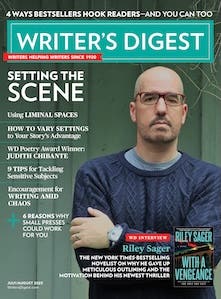Remembering Tony Hillerman
Novelist (and friend of WD) Tony Hillerman passed away this weekend, just a few weeks before his annual writing conference. As a tribute to his dedication to the writing profession, here’s a WD interview with Hillerman from our January 2000 issue.
7 QUESTIONS WITH TONY HILLERMAN
Writer's Digest, January 2000
by Brad Crawford
Tony Hillerman is best known for his Jim Chee and Joe Leaphorn mysteries set in the Southwest, but his resume includes 30 years as a newspaper reporter and editor, plus a post as the head of the journalism program at the University of New Mexico. He continues to writes fiction, essays, articles and nonfiction of all kinds. His latest work is Hunting Badger (HarperCollins), another Leaphorn mystery based partly on a 1998 Navajo police/FBI manhunt on the Utah/Arizona border.
Your mysteries tend to emphasis setting, description and culture. Do you consider yourself to be a “pure” mystery writer?
I feel my first priority as a writer is to entertain the audience. But I’m also fascinated by the cultures we have [in the Southwest], and I think people ought to know about them. My second priority is to develop plots that will force the reader to attend a Native ceremony or get involved in the religious tradition in order to follow the plot. Sometimes it works better than others.
Are you a visual writer?
I have to go to the reservation, to the spot I’ll be writing about to get comfortable with it. If something’s going to happen in the late evening, I want to be there at twilight and listen to what’s going on. Are the coyotes out there? Even if I never use a lot of this stuff, I like to feel at home in my mind with the spot I have on the page. Maybe I don’t put in the creosote bush and what it smells like when rainwater hits it, but I want to know.
Are there visual clues that you in-clude to entwine that setting with the story?
I’ve been out hiking with a Navajo before and noticed that he wouldn’t step in the water when crossing a ravine. “It shows respect for the water,” he said, which makes sense in a dry country. I try to remember those elements later on and use them as clues in stories. They might not tell a city cop anything, but they’ll tell Joe Leaphorn something.
How have you gone about researching for novels set outside the Southwest?
In Finding Moon, for example, I had planned to go to Laos to do research, but I couldn’t get a visa at the time. I could only get as far as Manila, so I modified the plot and went to Palawan Island [between Borneo and the Philippines] and moved a lot of the action there and to Manila. I have sons who are the right age to know a lot of Vietnam veterans, and I imposed on some of them who were in the so-called “Brown-water Navy” [which patrolled the Mekong in these little-bitty boats] and picked their brains. And, I did plenty of reading and sifted through National Geographic photos to get a sense of the setting and atmosphere.
You’re known for not liking to use outlines for your fiction.
I would do it if I could, but I can’t ever think ahead that far. When I decided I wanted to [write fiction], I analyzed what I had going for me. I’ve been a journalist for years and years. I knew what I was good at—narrative and description. I had no idea if could develop characters or a plot. That led me to a place where the setting is important, both in the landscape and the culture. Already being interested in Navajo culture, I decided the Southwest was a good place to do this.
Hunting Badger, though, has less Navajo culture in it. It involves a southern Ute legend, but it also involves a problem cops have, especially tribal cops—dealing with the FBI. A couple of years ago, we had a hellacious manhunt in the Four Corners area. A policeman was machine-gunned to death by three guys. . . . Hunting Badger chronicles a similar crime that takes place, and the fear that spreads through the Four Corners area because people are remembering what happened with this last manhunt. This story turns on the local cops’ work. [Joe Leap-horn] connects this crime with a legendary southern Ute hero who used to kill Navajos. That’s how the crime is solved, with the local cops knowing the area and the peculiarities of the culture.
You’ve had to scrap a large number of first chapters. Have you since found a way to avoid that?
Not yet. That happens when I’ve got the chronology wrong. I like a book to cover a relatively short period of time. Usually, when that happens, I’m starting the book too early in the event sequence, or it’s going to take too long for the principal character to appear. If I start the chapter at that point, I’ll leave the main character hanging so long that it will lose significance for the reader.
You’re working on a memoir—can you tell us about it?
I’m not sure what it’s going to be about yet. I’m working on it right now. I’ve gotten myself out of Pottawatomie County [Oklahoma], where I lived during the De-pression, and right now a couple of guys and I are winning WWII. I’ve collected notes and diaries from other guys who were in our company, and no two of us remember events the same way. I’m trying to write it from the viewpoint of a 19-year-old kid. Someone said that writing a memoir is like getting reacquainted with the person you were a long time ago. And it is. I hadn’t thought of it that way until I started doing it.


